By Jeffrey A. Rendall, Photos By Jeffrey A. Rendall
WINCHESTER, VA – The term’s not often mentioned in reference to golf, but sometimes the game fills a niche. Even rarer, perhaps, Rock Harbor Golf Course in Virginia’s famed Shenandoah Valley actually fills two of them.
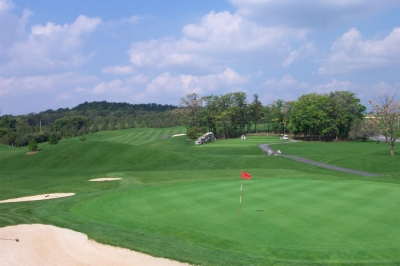 |
| From behind the par three 2nd hole's green. There's a rock wall near the tee, very appropriate to the setting. |
The Encarta Dictionary defines niche this way, at least when it comes to commerce: “An area of the market specializing in a particular type of product.” Hence, Rock Harbor’s niche number one.
The same dictionary defines niche in the ecological sense as “The role of an organism within its natural environment that determines its relations with other organisms and ensures its relations with other organisms and ensures its survival.”
Rock Harbor opened last year (2003), satisfying a desperate need in the northern part of the Shenandoah Valley for an upscale, daily fee golf facility -- it wouldn’t be a stretch to say, in the commerce sense, Rock Harbor filled that niche. Similarly, the golf course filled an ‘ecological’ niche by providing a legally required buffer zone between a gravel quarry and the surrounding farms and residential areas.
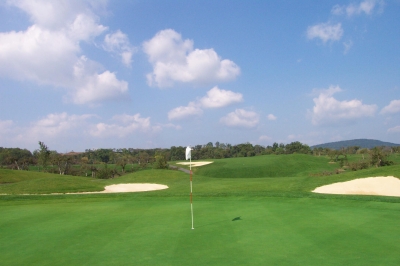 |
| The 478-yard, par four 15th hole is Rock Harbor's #2 handicap hole -- and for those trying to cut the dogleg off the tee, they may end up in the apple orchard. |
Jerry Wampler, Rock Harbor’s Head Golf Professional, tells how the course came about: “Our owner, Denny Perry is an avid golfer, and ever since I’ve known him, he’s talked about wanting to build a golf course. His family owns the quarry next to us, and he thought this orchard land would make for a good place to build that dream. When it became available, he bought it, and the rest fell into place from there.”
Perry didn’t necessarily let things fall into place as much as he carved them into the former farm and orchard land (there are still several acres of apple orchards remaining on property). Wampler says except for the greens and tees, Perry and his construction crew pretty much built the golf course themselves. Though Perry’s not exactly descended or schooled from a natural bloodline of golf course architects, he did his homework and designed the course himself.
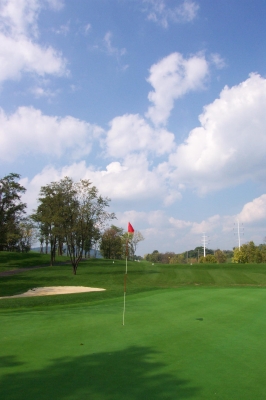 |
| There're a couple holes with tall flagsticks -- to make sure you can see the pin location from the fairway. Here, the par five 8th hole. |
The result being a pretty solid 18-hole golf course, fresh with a tremendous amount of variety mixed in along the way. The current routing is a bit of an ‘adventure,’ but that should iron itself out in time, as the facility stretches out to its originally intended 36-hole variety. As currently played, a few of the holes are a bit too close to each other, the cart paths at certain points seem to go in some strange directions, and you’ll have a hard time figuring where to hit the ball on your first trip around the course (on a few holes).
Those ‘bumps’ aside, Rock Harbor is a nice place to play golf. The Shenandoah Valley is as rich in history as it is in beauty, and Rock Harbor resides in a spot where you can easily take advantage of both of those attributes. The golf course isn’t far from the Cedar Creek Civil War Battlefield, and the valley’s scenic views are all around you – in other words, an entire day can be planned that doesn’t just include golf.
Or, you can just come to play, too. Wampler said it wasn’t as tough to build the course as you might think, considering this was Perry’s first golf venture: “It’s true that Denny had never built a golf course, but he’d seen a lot of great courses, took some classes, and because he was in a construction-oriented business, he understood golf course ‘requirements’ like lay of the land, slopes and drainage issues. He had some help with the golf elements he wasn’t that familiar with, so the course turned out even and well thought-out.”
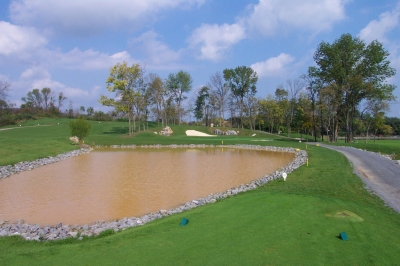 |
| The short par three (135 yards) 13th hole is a needed break after the incredibly long par five 12th (692 yards). |
Happily, yes it did. As alluded to above, there are some quirky elements at Rock Harbor, but the preponderance of the golf experience makes up for a few inconveniences. Because the property (from a zoning sense, next to a quarry) isn’t suitable for real estate, there aren’t any houses on the course, and there are some truly unique design concepts on the layout that you don’t encounter very often.
The most notable being Rock Harbor’s signature 7th hole, a 171-yard par three playing downhill to an island green. The island sits in the middle of a large lake that also fronts three other greens – a logistical situation that can be a bit confusing on your maiden round on the course (better listen to the starter’s instructions, or you could very well hit to the wrong green).
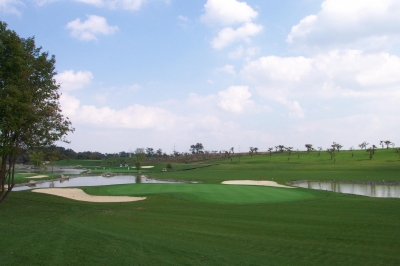 |
| Near the green on the 634-yard, par five 5th hole. Directly across the water is the 12th -- now those are two long par fives. |
In addition to the lake’s island putting surface, there’s also a peninsula green on the par five 5th hole, and you’ll be firing over the same body of water to the par five 12th and par three 14th holes’ greens, as well.
True to its name, there’s a plethora of rock at Rock Harbor – lining the bodies of water, but also jutting out in spots. Most of the layout is semi-pastoral in nature, but for those holes next to the lake, you’ll be aware of it (note: there are also a couple ponds on the course).
Perhaps the most unique thing of all, Rock Harbor’s got the longest par five we’ve ever seen, the 12th hole – measuring 692 yards from the back tees. You’ll get a bit of a boost off the tee, since the landing area is quite a bit below you – but we doubt anyone will be reaching this one in two, considering you’ll have to carry water to reach the green.
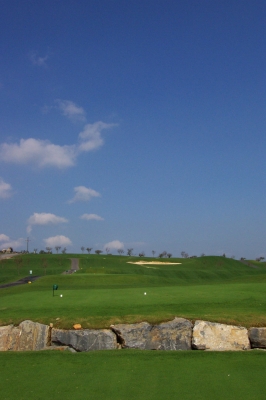 |
| A look from the tee of the par three 11th hole. It's straight uphill to the green, creating a love/hate relationship for most players. |
Following those nearly 700 yards of golf real estate is a 135-yard par three… go figure. Where Perry taketh away on one link, he giveth back on the next hole.
Six tee boxes help to even things out a bit for people not as inclined to challenge those types of yardage anomalies. “Our biggest challenge,” Wampler says, “is to make sure people play the yardage that’s suitable to them on this golf course. Too many times people look at the scorecard and decide to play based on tee color. Here, that can make certain holes nearly impossible.”
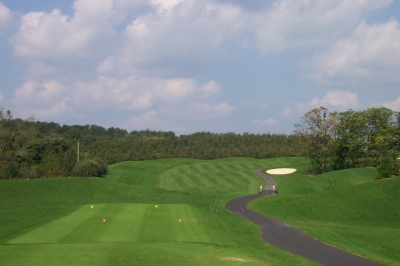 |
| Even the 'easy' holes have some challenge at Rock Harbor. The par four 3rd hole carries the #17 handicap, but you've still got to place your drive on the correct spot on the fairway to have a good shot at the green. |
As currently configured, you’ll notice quite a few uphill shots on the course, which makes it play even longer than its listed yardage of 7151 (par 71) yards from the tips. Most dramatic is the par three 11th hole, which plays 206 yards in distance but requires a couple extra clubs to climb the steep hill (the slope of the green is no picnic, either).
According to Wampler, it’s the hole people hate the most, but it’s also the one they want to come back and try again: “The eleventh hole gets by far the most comments, but being the most talked about hole, it seems to intrigue people. They’ll say ‘I’m going to play that thing ‘til I get it right.’ I think, if you play it from the correct set of tees, it’s not as bad as it could be. Some people kind of bring that difficulty on themselves, and that hole just exploits it a little bit.”
Wampler acknowledges the presence of more than their share of uphill shots, and says that’ll be changed (along with the somewhat intemperate routing) when the new golf holes are built and opened: “All 36 holes have been laid out, and although only 18 are currently open, we’ve intended to have only so many uphill holes on each nine. You’ll have about two uphill holes on each nine instead of maybe double that right now, so the playing nature will change.”
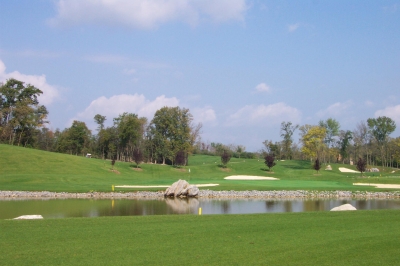 |
| Close to the green on the par five 12th hole, with maybe 100 yards left from here. To get to this point, you've already played nearly 600 yards on this hole. |
The ‘new’ holes are under construction (one nine is cut out and ready to be shaped, and they’re clearing the final nine), but probably won’t be open until at least 2006. In the meantime, they’ll continue to landscape the existing course and upgrade the facilities, such as the cart paths.
It’ll all make sense in the end, rest assured.
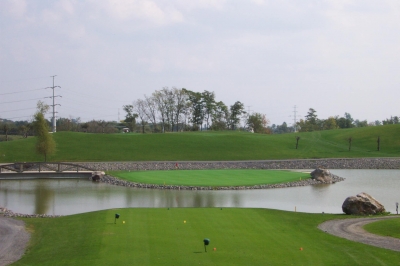 |
| Rock Harbor's signature 7th hole. As is true with most island greens, it's actually a lot bigger than it looks. |
“When people first see the course, they’ll wonder why we did it the way we did,” Wampler said. “But after a few times, they’ll know where to hit the ball and drive their carts. People also have to realize that we built the current 18-hole course so they could play without construction interruptions that will come in the future. We thought it’d be better to have it a little crazy for the first few years rather than subject people to hole closings and the like when we start finishing the other golf holes.”
The 36-hole facility, when complete, will offer two outward starting holes and two finishing holes that’ll be served by a new clubhouse. Again, it’s all in the future plans.
One thing that no one will ever wonder about is the course conditioning. For a layout that’s only been open a year, Rock Harbor is in excellent shape, including the rough areas (probably almost too lush, but Wampler said they’d let the rough grow up a bit in preparation for a tournament to be held two days after our visit).
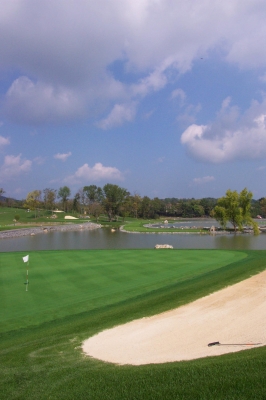 |
| Not far from the 7th green is the par three 14th hole -- but this time, if you miss long or left, you're still dry. |
It’s more than good land and great care, it’s in the water, too. “We’ll be in good shape year round because we have an unlimited water supply. That won’t make a lot of difference in a wet year like this one, but in a dry summer when some other areas are a bit parched, we’ll have all the water we’ll want, because it comes from the quarry,” Wampler said.
That’s a benefit of having a common owner who just happens to run the business next door… wish everyone could plan it that way.
One final note – Rock Harbor’s A-4 bentgrass greens will ensure pristine putting surfaces, slick and a thorough test of your flat stroke. Their large size is friendly to the public player, yet undulating enough to allow for championship pin positions. Like the rest of the club, well thought-out.
Wampler sums up the Rock Harbor experience: “First and foremost, we want our players to have fun, and we want ‘em to feel like they’re welcome. We do sell a few memberships, but most of our players are public daily-fee. We want them to see a golf course that’s in very, very good shape and priced just right so it goes hand-in-hand with the whole outing.”
It’s almost like filling a niche – and in Rock Harbor’s case, more than one.
Note: Check links below for more reviews of Northern Virginia golf courses.
Details:
Phone: (540) 722-7111;
Toll-Free (866) 273-1934
Website: www.rockharborgolf.com
Course Designer/Owner: Denny Perry
Head Golf Professional: Jerry Wampler
Tees/Yardage/Slope/Rating
Black 7151 136/74.7
Blue 6695 127/72.1
White 6265 118/70.2
Orange 5388 113/64.0
Yellow 4772 105/64.0
Green 3855 NR/NR
Rates (2004; Consult the website for winter and 2005 rates):
M-Th: $35; Friday: $41; Weekends & Holidays: $54
Rates include cart.
Weekday Walking rates: M-Th: $19; Friday (twilight only): $15.
Twilight: $29, $34, $34. Call the proshop for twilight starting times.
Twilight walking rate: $15, seven days a week.
Replay rates available.
Walking is allowed anytime on weekdays, and after three on weekends. The course has some ups and downs and a long walk between the 14th green and 15th tee, but other than that, is fairly walkable if you’re in good shape.
Fee for range balls, $4 for a warm-up bucket, $9 for a large bucket.
| Related Links | Comments on this article? | |
|
Maryland National Golf Club Hollow Creek Golf Club Rocky Gap Resort PB Dye Golf Club in Ijamsville Whiskey Creek Golf Club |
E-mail Jeff Rendall, Editor: jrendall@golftheunitedstates.com |











